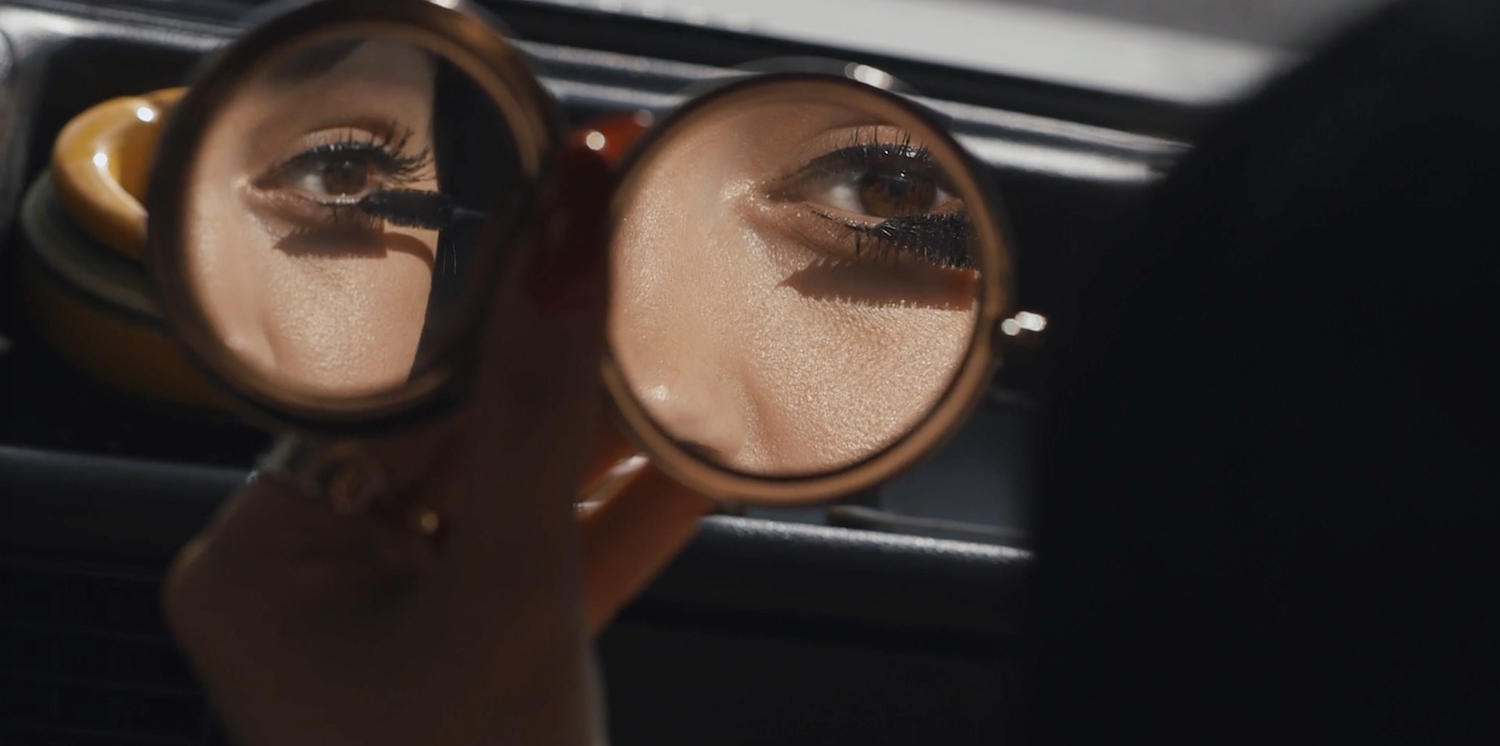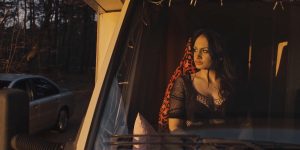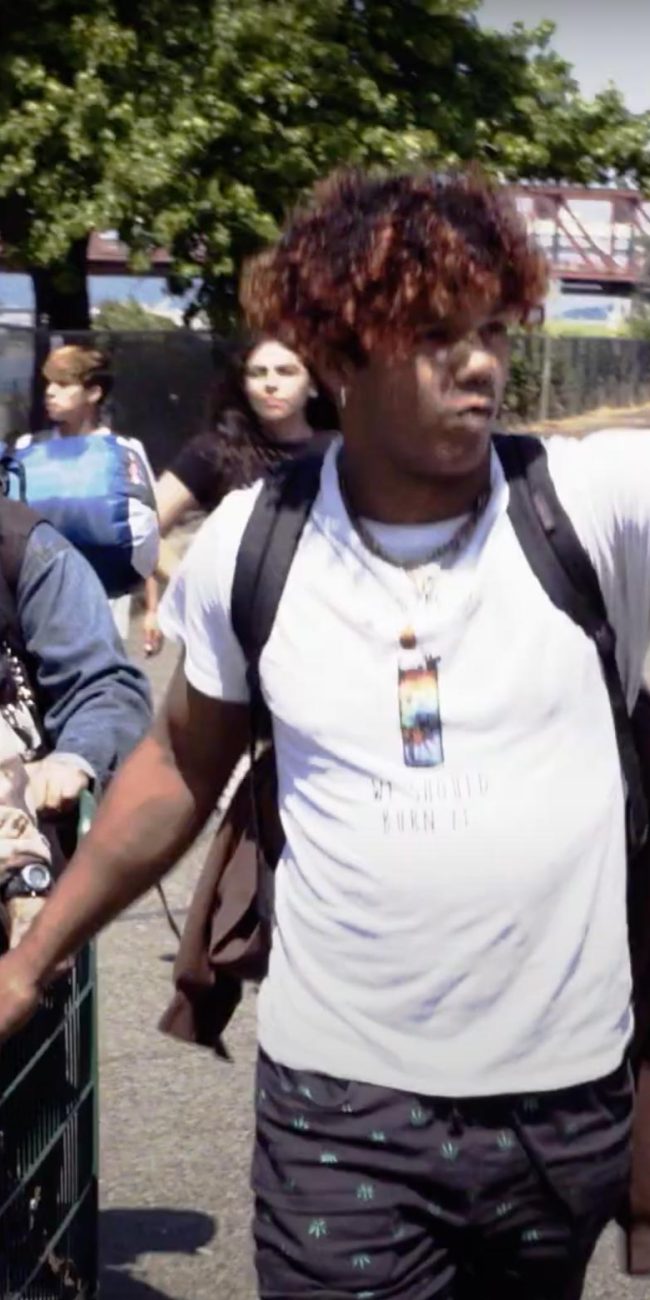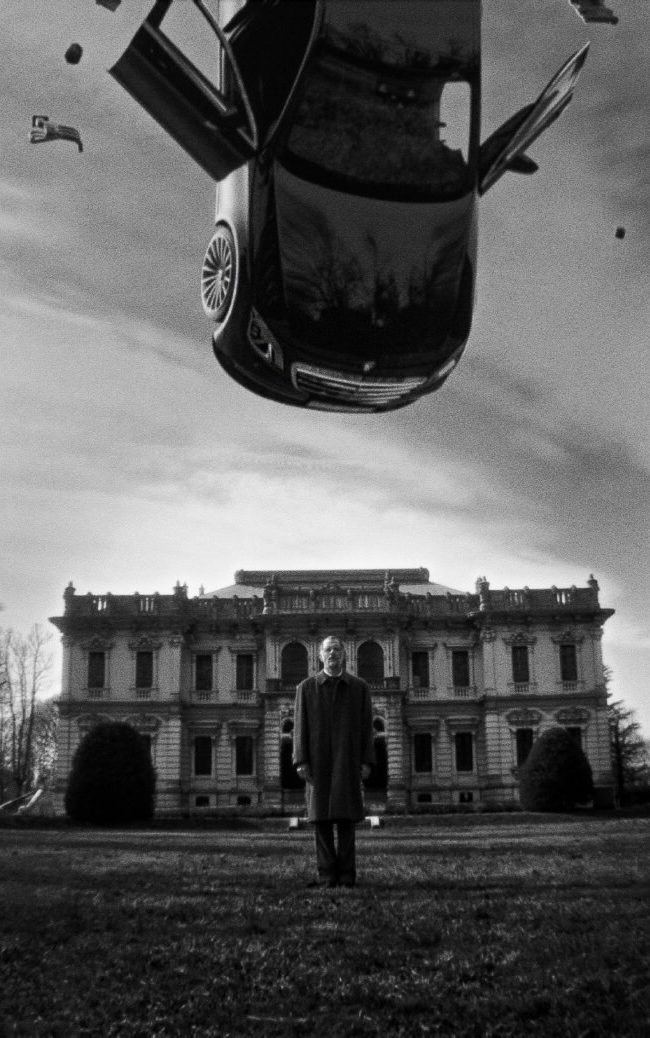THE TRUTH BEHIND LOVEMOBIL? A CONVERSATION WITH ELKE LEHRENKRAUSS

At the 2020 Slamdance Film Festival, I met with director Elke Margarete Lehrenkrauss to interview her about Lovemobil (which I reviewed), her documentary about foreign sex workers in Germany who ply their trade in camper trailers (the titular “lovemobils”) stationed on the side of the road. I really loved the movie, with its intimate, behind-the-scenes look at the daily lives of women struggling to survive in a difficult world, three of whom – the German Uschi (a former sex worker, now renter of campers), Bulgarian Milena and Nigerian Rita – serve as primary subjects. The beautiful cinematography did not hurt, either. I was by far not the only one who appreciated Lehrenkrauss’s achievement, as the film won a number of prizes last year and racked up plenty of positive reviews.
Unfortunately, it turns out that the truth about the movie’s content was not quite as presented, since it featured staged scenes that were not labeled as such. Lehrenkrauss’s broadcaster partner, NDR (Norddeutscher Rundfunk), recently pulled Lovemobil from distribution over these revelations. I will admit that it came as something of a shock when I received a tweeted message about this growing scandal, as nowhere in our published interview did Lehrenkrauss once mention any use of recreations or reenactments. That said, she is hardly the first documentarian to mix fiction and nonfiction elements in a hybrid amalgam. The rules and conventions of filmmaking evolve over time, and what was once considered taboo is now quite common.
Still, there is no question that we as viewers come to documentaries with certain expectations, foremost among them the notion that what we are watching is made up of elements drawn directly from real life, however manipulated they may be. Almost all films – fiction, nonfiction and in between – involve editing, musical scoring and other techniques that affect our perception of the image, transforming the ostensible objectivity of the image (if such a thing exists) through directorial mise-en-scène. And even those rare movies that might not appear to include any editing at all (e.g., a static camera filming for hours) still affect how we see the world through their compositional inclusion/exclusion. The filmmaker’s lens always simultaneously tells the truth and lies, in other words.
In this 21st century of ours, we have become sophisticated enough consumers of the moving image to understand all of this. We are able (one hopes) to easily differentiate between the nonfiction and fiction sections in something like Errol Morris’s 2017 Netflix limited series Wormwood, where we toggle between an interview with the subject and flashbacks in which his father is played by the actor Peter Sarsgaard. These techniques, plus others borrowed from the narrative tradition, have enriched the art of the documentary, pushing its boundaries beyond the one-time polarities of omnisciently narrated news gathering and cinéma vérité. However one may feel about that evolution, never forget that Robert Flaherty’s groundbreaking 1922 Nanook of the North, one of the first feature-length documentaries, included numerous (never labeled) staged scenes in which the director altered the natural course of events to suit his creative purpose.
Which brings us back to Lehrenkrauss and her Lovemobil. Despite all that I have just written, I nevertheless expect, in something called a documentary, to be watching real people talking about their own experiences, unless it is evident, either via onscreen text or clear context, that what I am seeing is, at that moment, an act of creative artifice. Sometimes a filmmaker may be coy by riding the line between real and not-real (and what is the graffiti artist Banksy’s 2010 Exit Through the Gift Shop but an exercise in coyness?), yet such work usually wins us over because we quickly understand that so-called reality is not the point of the endeavor. Sadly for Lehrenkrauss, the entire attraction of her movie stems from our belief that we are witnessing the raw, unvarnished truth, however stylized the compositions. And so, curious, I contacted her and arranged a second interview (via Zoom). Here is a condensed digest of our conversation, edited for length and clarity.

Filmmaker Elke Margarete Lehrenkrauss
Hammer to Nail: Thank you for agreeing to chat with me again, Elke. I want to start with the most basic question, given what has recently come out. Of your three main characters in the film – Uschi, Milena, and Rita – who is actually a real subject talking about her own personal experiences?
Elke Lehrenkrauss: Well, Uschi is a real subject. Everything we tell about her is absolutely her story and her life up to the smallest details. Milena is an actual sex worker, but one who has not worked in the lovemobil. For our film, she moved into the lovemobil and she tells part of her own story mixed with the stories of others she’s interpreting. For example, her friend, the boxer in the film, is her real friend. It’s kind of a mixture. And Rita is a character based on a character we found and we wanted to shoot the film with, but she got pregnant. For ethical reasons, you can’t shoot a film with her when, after the film, she steps into a new life. Then the film comes out and boom, everybody knows what she was doing before. So we couldn’t do that. And then I met the person who plays Rita in Berlin. She was a student and she liked the ethical approach of the film and she wanted to contribute to the project. And so she decided she would take the part of that girl. But she always knew, and everybody was always aware, that we were making a documentary.
HtN: So, she plays Rita. Are those stories that she tells, those experiences, all from that one character who became pregnant?
EL: Not only. There are also other experiences. It’s a mixture because she did her own research because she’s a very smart person who also wanted to contribute with her own words. It was something that we developed on set together. But everything that is in the film is based on true events, on true observations we really made. There’s nothing we invented. Not even putting laundry on a line or cooking or anything. Every detail we had observed during our research.
HtN: And to clarify, Milena is from Bulgaria and she has been a sex worker but just not in the lovemobil.
EL: Yes.
HtN: Right. In a sense, what you’re doing is creating reenactments.
EL: Yes.
HtN: Which is certainly something that people do. But why did you decide not to be clearer in your presentation of the parts of your film that are composites or that are effectively reenactments using these women? Certainly, we’ve seen a lot of hybrid techniques in documentaries for a while, but I think the audience often comes to something labeled a documentary with an expectation that what they’re going to be seeing, unless they’re told otherwise, is of actual people talking about their experiences. How did you navigate that? And why did you decide to take the approach that you chose?
EL: The approach that I chose to put this topic on screen came about through gradual development. We wanted to try out if it would even work with the reenactments. We weren’t sure this is going to work. It could have been very bad acting. As to why I didn’t tell, it has nothing to do with…I know I should have labeled it, but it is something I did not do out of fear of pushback from German broadcasting stations. Germany is a little different regarding hybrid formats than the U.S. In Germany you have to deliver “direct cinema” to the broadcasting stations. There was simply no common ground between me and my commissioning editor to really talk about it and so I just didn’t tell. It was actually out of fear, as he could possibly kill the film. One thing led to another, and I didn’t tell him.
Then I got myself into something. I didn’t tell it to festivals because then that would be online and he would read about it. So I got myself into something very problematic. If it would have been an independent production, perhaps not made in Germany, it wouldn’t have been a problem labeling it, saying, “Okay, this is a reenactment based on true events and it’s a mixture. It’s a hybrid between fiction and documentary or it’s a documentary that uses fictional characters or uses actors to stage what we have experienced.” But it was just a big communication problem.
HtN: Are you familiar with the documentary Searching Eva?
EL: Of course, the director, Pia Hellenthal, is a friend of mine.
HtN: Well, I interviewed her, and she uses a male actor at one point in a scene of a john coming into the room with her main character.
EL: Oh, really? I didn’t know.

A still from LOVEMOBIL
HtN: (laughs) Well, it’s public knowledge now because she told me and it’s in the published interview. It’s an element where she wanted to film a john with Eva and so she used an actor. And that is, in a sense, a reenactment of a sex scene because it’s maybe hard to negotiate getting somebody to come in and be on camera as a client. But otherwise, as far as I know, we’re seeing a stylized, but real, version of Eva Collé, the main subject. But still, it’s a very stylized version. Has that film bothered German broadcasters? Do you know?
EL: I do know. But it wasn’t co-produced with a broadcasting station. It was free from that influence. There was no broadcasting station. I totally support that film. I love it. I think it’s a great film. But I do know that many voices in Germany are, let’s say, “classical.” And that is the big gap we have here between those who are free artists who want to create new forms, who want to tell stories in a different way, and who want to approach a subject in a different way. But there are others who just defend the classical way, the direct cinema, which is also a great thing. But I think it always depends on the topic. For me, it’s not my style to only want to make hybrid films. But for this topic, it was necessary in order to put something on screen, to make it visible and to create this atmosphere. That was an artistic decision. It was a stupid decision not to label it, though.
HtN: How might you label it, going forward? Would it be enough to put a simple title card in the beginning indicating that some scenes are staged? Or are you thinking of labeling individual scenes? What is your approach going to be now?
EL: I think, by now, I don’t even have to label it because everybody knows. (laughs) But, let’s step back in time. Like, one or two years before, I think I should have done like Pia. She did something very smart. In the credits, she didn’t write the names. She just said “cast,” and then she wrote the names. That would be one possible way. For every character that is a character, write the real name and the other name. And then you can indicate it that way, in a sense saying, “Okay, this is a real character; this is not.” And then also maybe indicate that this is a hybrid documentary, or fictional documentary using elements of staging.
HtN: So, how did this come out? On our website, Hammer to Nail, while we haven’t been bombarded, we have received some emails about your film. It seems like there are a few very passionate, shall we say angry, people who want to make sure that everybody knows that your film has actors. It’s a little weird that they’re sending emails to remind us. I don’t know why. I mean, sure, maybe they’re legitimately upset, but how did this come out now and who is so angry?
EL: I think the broadcasting station was angry. It’s a little more complex, in a way, because you do not have artistic formats on broadcasting stations. Everything has to be real. We have a big problem here with fake news and the right wing who always say that the press lies. And in this difficult situation, broadcasting stations have to make sure that everything they show on TV is absolutely real. Which, of course, it is not. There are so many things that are not real. And somebody just started to pick my film as an example. And so the broadcasting station has to defend their reputation and say everything is my fault so they get out without any harm. Do you understand?
HtN: Yes. But was there, in addition, one particular person who had a grudge against you and wanted everybody to know?
EL: Yes, there was. There was an editor I was in trouble with and she didn’t give back my hard drive with the material. And after one-and-a-half years, she decided to go to the broadcasting station and tell them and make a scandal. And there was this independent YouTube channel within the broadcasting station, as well. I think they needed a story. And because it’s the time of the coronavirus, there’s not so much going on, and they needed a story and so they made a story about it. Sometimes, something just happens. And then everybody is telling all sorts of things. There are so many wrong things in the air now about my film.
HtN: The good news is that at some point people will move on, right?
EL: Yes. I hope so. I was always hoping, “Where’s Putin? Can he not make an atomic bomb or something or can Trump not do anything so everybody will get distracted?” (laughs) No, I’m just joking.

A still from LOVEMOBIL
HtN: Your film won some awards, including a pretty major one in Germany. Will there be any consequences about those awards? Have you heard from anyone?
EL: One award, I would give back on my own, because it is an award from a broadcasting station. And I know, for them, it would be better if I gave back the award. But there is also another award where the jury decided not to cancel it because they gave the prize to the film because they liked the style, they liked the atmosphere, they liked the artistic approach. So, there are also different voices in the juries. And for them, it was clear that things are staged and they didn’t care. They think it’s a good movie.
HtN: What is that award?
EL: Friedensfilmpreis. It is a Peace Film award. They decided they didn’t want it back.
HtN: How far do you think a filmmaker, when working in an ostensibly nonfiction format, can push the limits of filmmaking using fictional techniques? How far should one go in terms of using staged reenactments, whether you label them or not? At what point does it stop being a documentary, in your mind?
EL: In my mind, it stops being a documentary when you start inventing stories that have never taken place. For example, if I would invent the caravans on the side of the road and invent a character like Uschi or something. The moment you invent a reality that doesn’t exist, that is, for me, the limit. Then it’s clearly a fiction.
HtN: Right. It’s like when I’m editing interviews, I often change phrases a little bit to make them flow better. I might take out words if you repeat yourself, but I never change what people are actually saying, in the general sense, even as I edit the paragraph down.
EL: You are using techniques like this, too. But you don’t present a person in a different light. So that is where, for me, it stops being true…I mean you can say everything is film, art is free, everything can be conceptual. But I think, also, that the audience can decide where the lines have to be drawn. For me, they are there.
HtN: So, for example, in this interview, if you read later that you, Elke Lehrenkrauss, said that everything is permissible in documentary filmmaking, you’ll know that I changed your words. (laughs)
EL: (laughs) Please don’t. I’m in big trouble, already. So don’t get me into more trouble.
HtN: I shall not! I will not change your words other than to edit the text a little.
EL: No problem.
HtN: Well, Elke, thank you! I appreciate you talking to me again.
EL: Thank you so much.
– Christopher Llewellyn Reed (@ChrisReedFilm)












Johnny
Wow, breath taking….!!! She did nothing wrong in the end, eh? 🤣 and the characters are all real, eh? Hillarious….